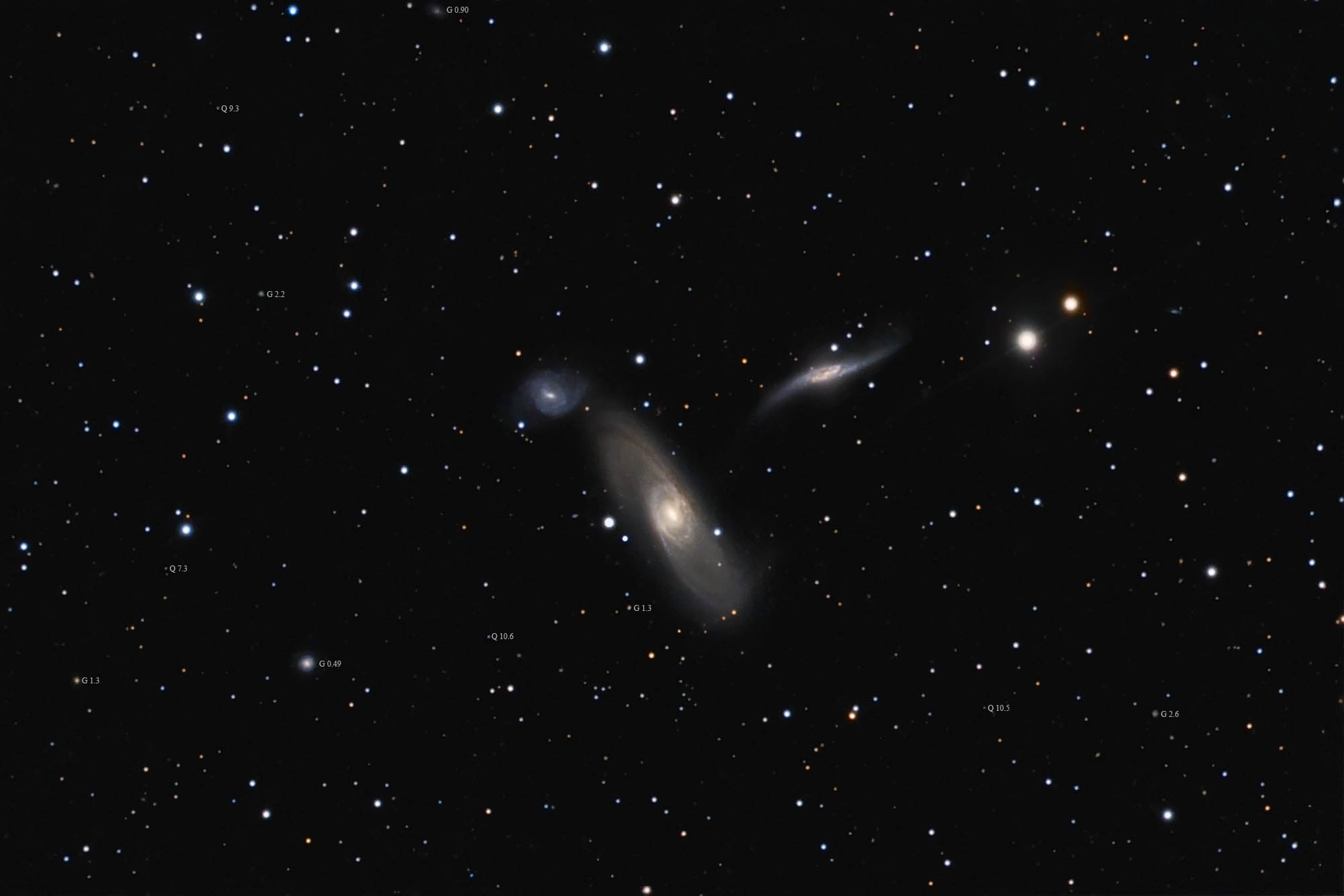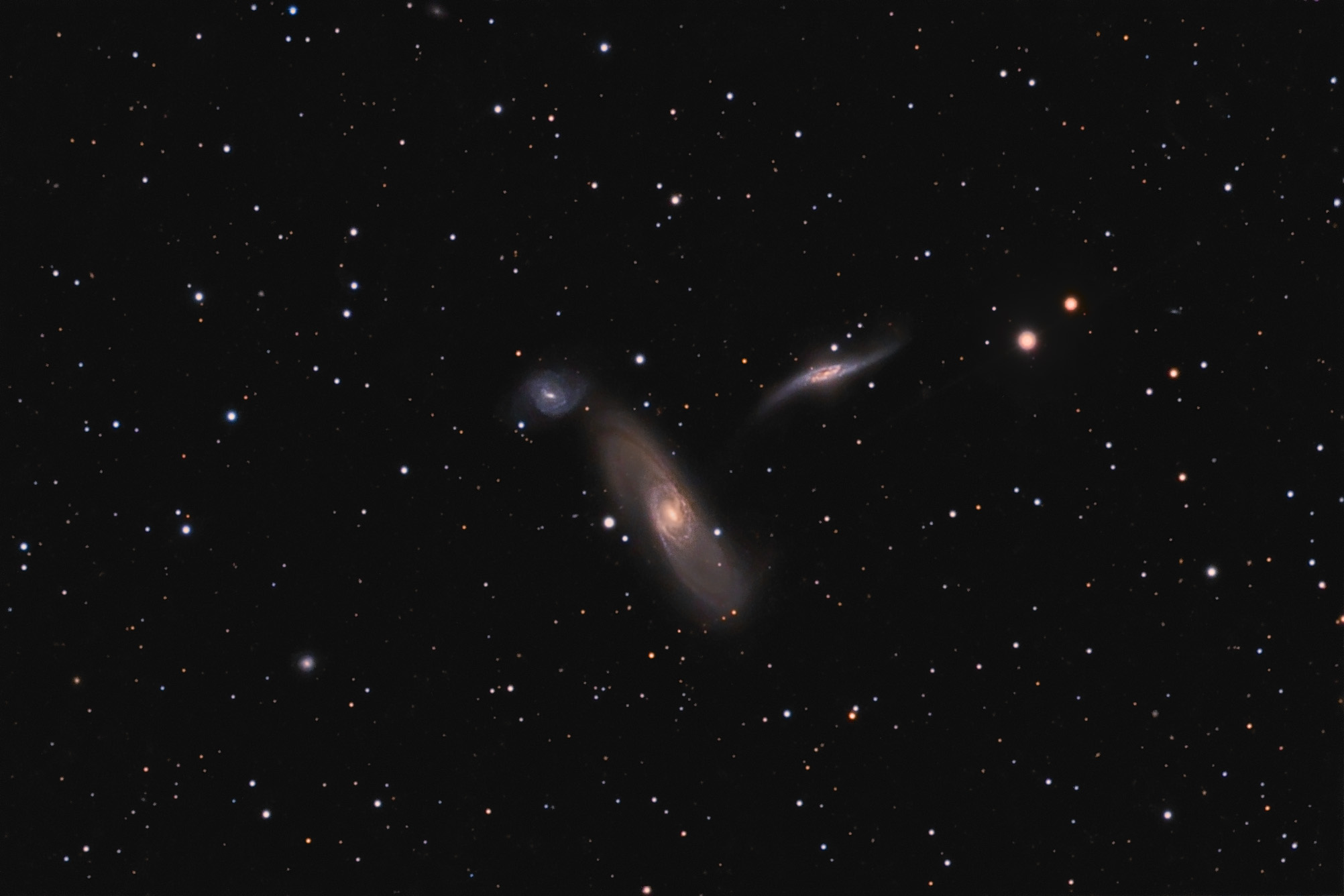| Description | Images |
Object name: ARP286Designation(s): ARP286, NGC5560, NGC5566, NGC5569, Arp 286 consists of three galaxies, NGC 5560, NGC 5566 and NGC 5569 right to left in my image. They are in the constellation of Virgo about 80 to 90 light-years distant. Arp put them in his category: Galaxy groups: Infall and attraction. This likely refers to NGC 5560 and NGC 5566 as NGC 5560 appears warped and drawn out by the gravity of NGC 5566. NGC 5566 itself seems distorted. The outer "arms" look more like plumes and are somewhat unsymmetrical. Also, the northern one has a prominent reddish dust lane that's hard to explain other than by tidal effects. Also, I think its disk appears slightly warped as well. Arp's comment on this entry reads: "Connection not visible." I see no tidal star streams connecting any of the three, though there is a faint plume coming off the south end of NGC 5566 heading to NGC 5560. A much longer exposure might show a connection. NGC 5569 seems unfazed and likely is more a line of sight member that appears far closer to the other two than is really the case. Related Designation(s):2MASS J14200451+0359337, 2MASS J14201988+0356013, 2MASX J14200449+0359335, 2MASX J14200543+0359285, 2MASX J14201994+0356009, 2MASX J14203215+0358594, 2MFGC 11651, AKARI J1420039+035937, AKARI J1420199+035611, ARP 286, ARP 286 NED01, ARP 286 NED02, ARP 286 NED03, ARP286, ASK 100146.0, CGCG 047-010, CGCG 047-012, CGCG 047-013, CGCG 1417.5+0413, CGCG 1417.8+0409, CGCG 1418.0+0412, GALEXASC J142032.01+035901.2 , GALEXMSC J142032.31+035858.4 , HDCE 0869 NED001, HDCE 0869 NED002, HIPASS J1420+03, HIR J1420+0358, HOLM 630, HOLM 630A, HOLM 630B, HOLM 630C, IRAS 14175+0413, IRAS 14178+0409, IRAS F14175+0413, KTG 54, KTG 54A, KTG 54B, KTG 54C, LDCE 1076 NED006, LDCE 1076 NED007, LGG 379:[G93] 001, LGG 379:[G93] 002, LGG 379:[G93] 003, MCG +01-37-001, MCG +01-37-002, MCG +01-37-003, NGC 5560, NGC 5566, NGC 5569, NGC5560, NGC5566, NGC5569, NSA 017878, NSA 164836, NSA 164850, NVSS J142004+035931, NVSS J142020+035603, PGC 051223, PGC 051233, PGC 051241, SDSS J142005.38+035927.4, SDSS J142019.88+035601.4, SDSS J142032.08+035859.5, SDSS J142032.09+035859.5, SDSS J142032.09+035859.6, UGC 09172, UGC 09175, UGC 09176, USGC U616 NED04, USGC U616 NED05, USGC U616 NED06, UZC J142004.4+035933, UZC J142020.0+035602, UZC J142032.2+035900, UZC-CG 214 NED01, UZC-CG 214 NED02, UZC-CG 214 NED03, WBL 501-001, WBL 501-002, WBL 501-003, WVFSCC J142028+040014, [BEC2010] HRS 310, [BEC2010] HRS 311, [M98j] 226 NED01, [M98j] 226 NED02, |

